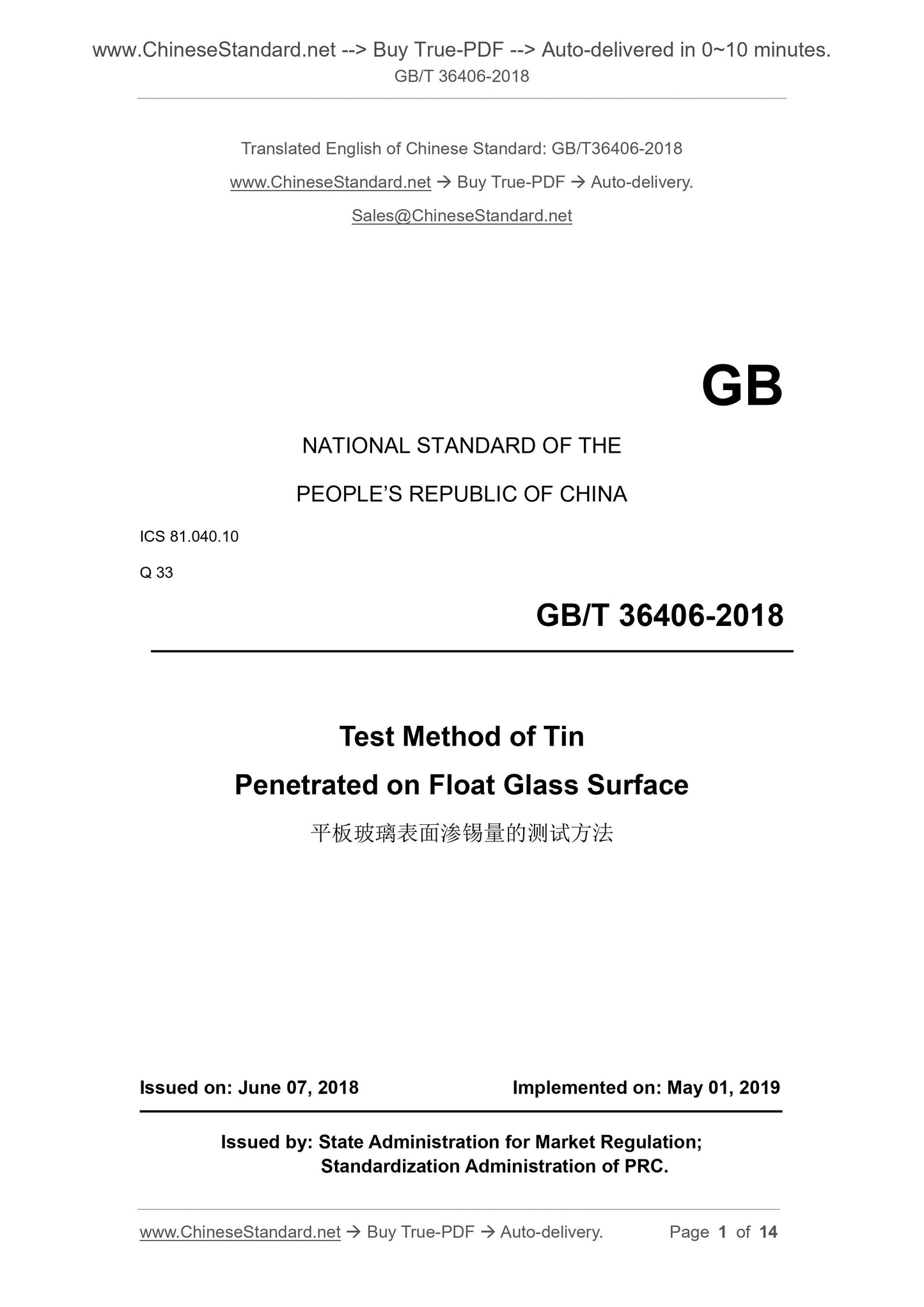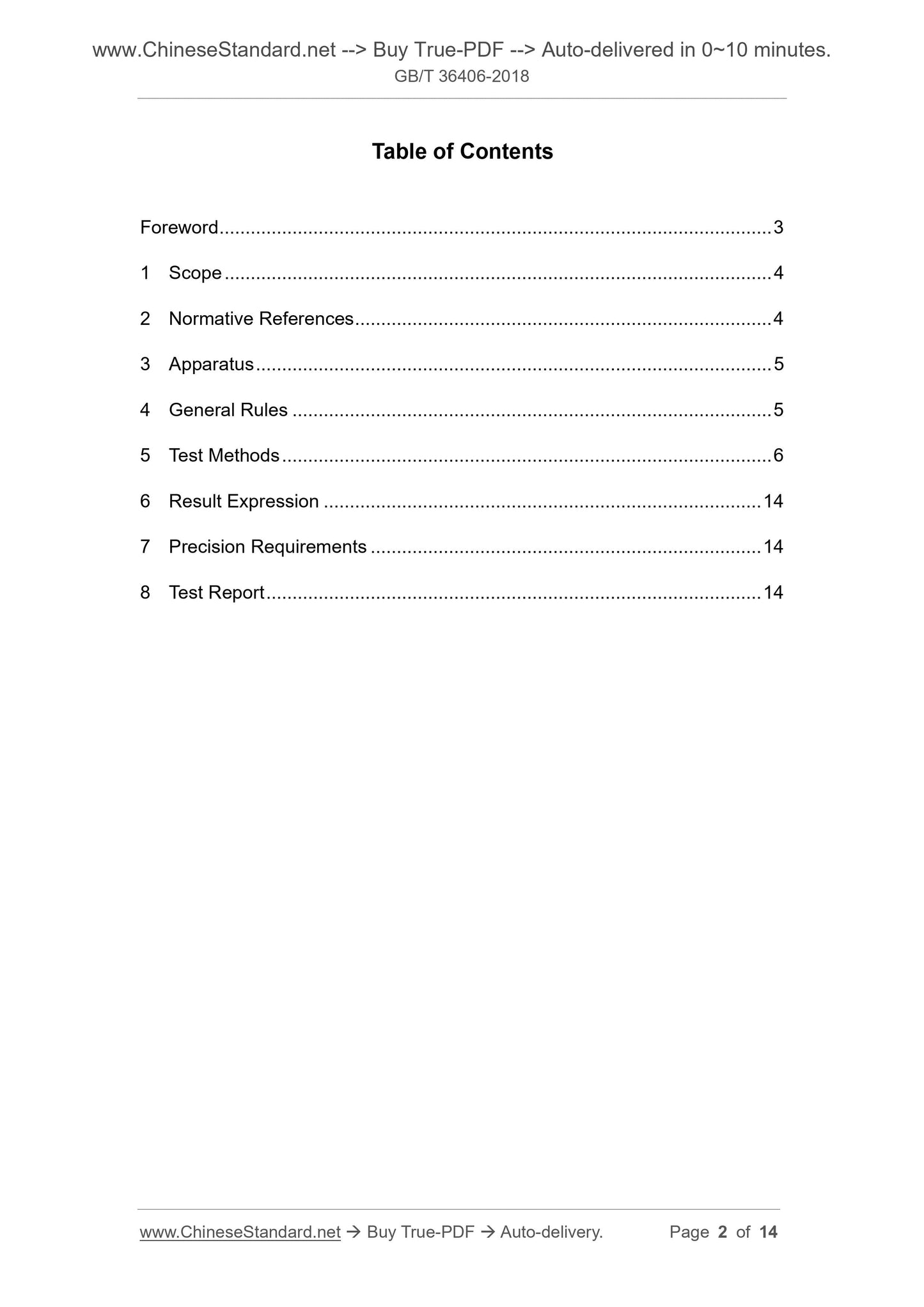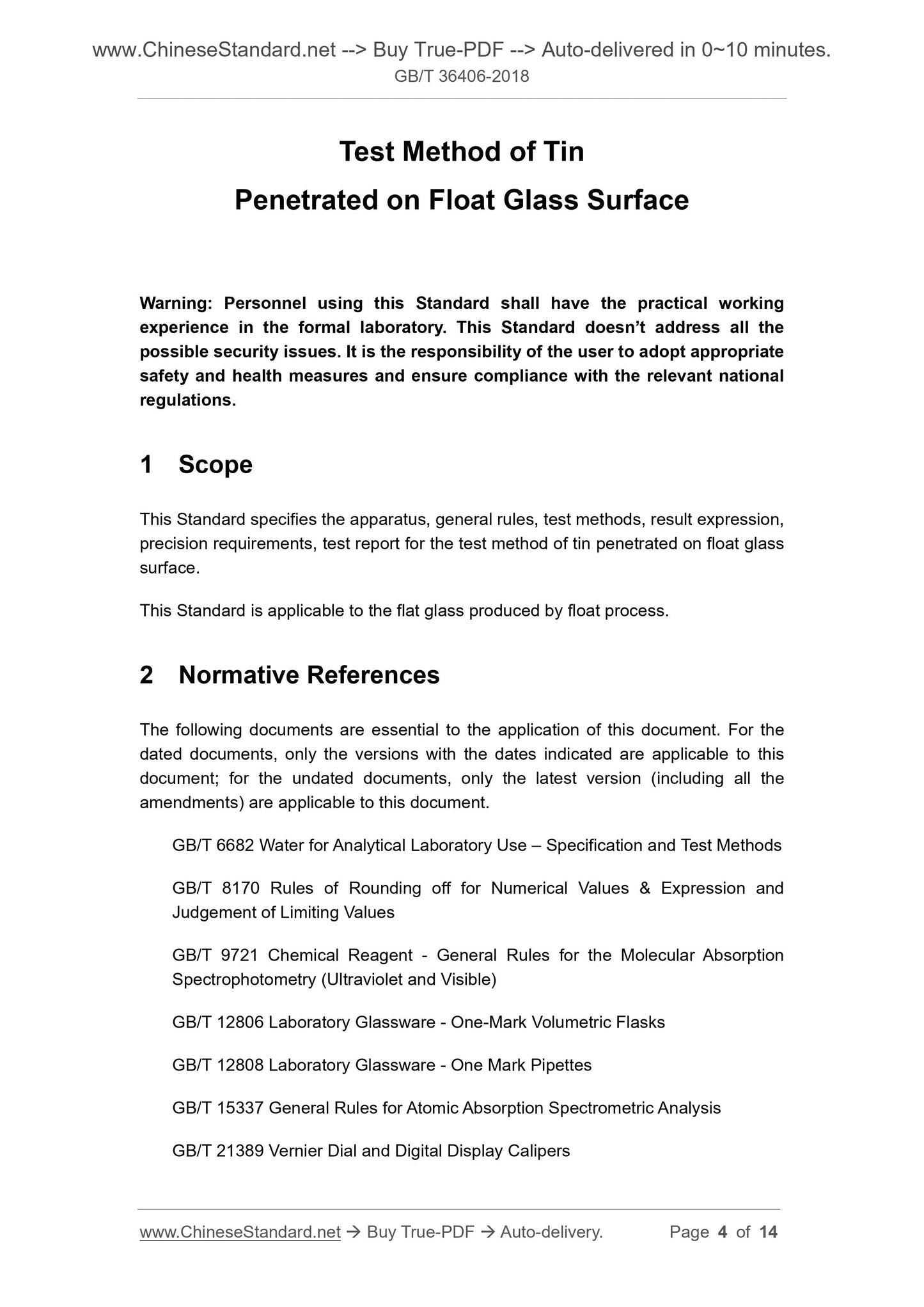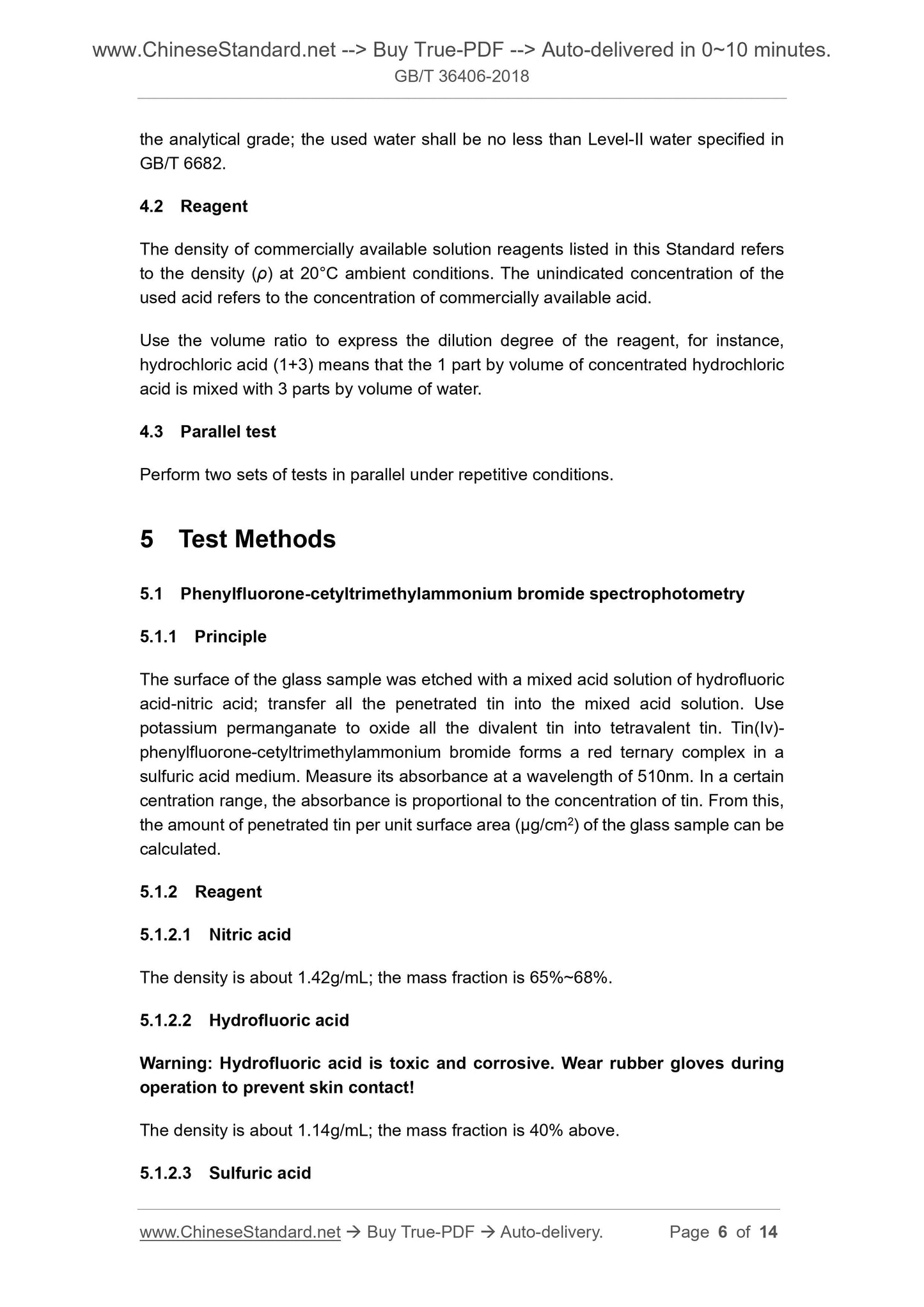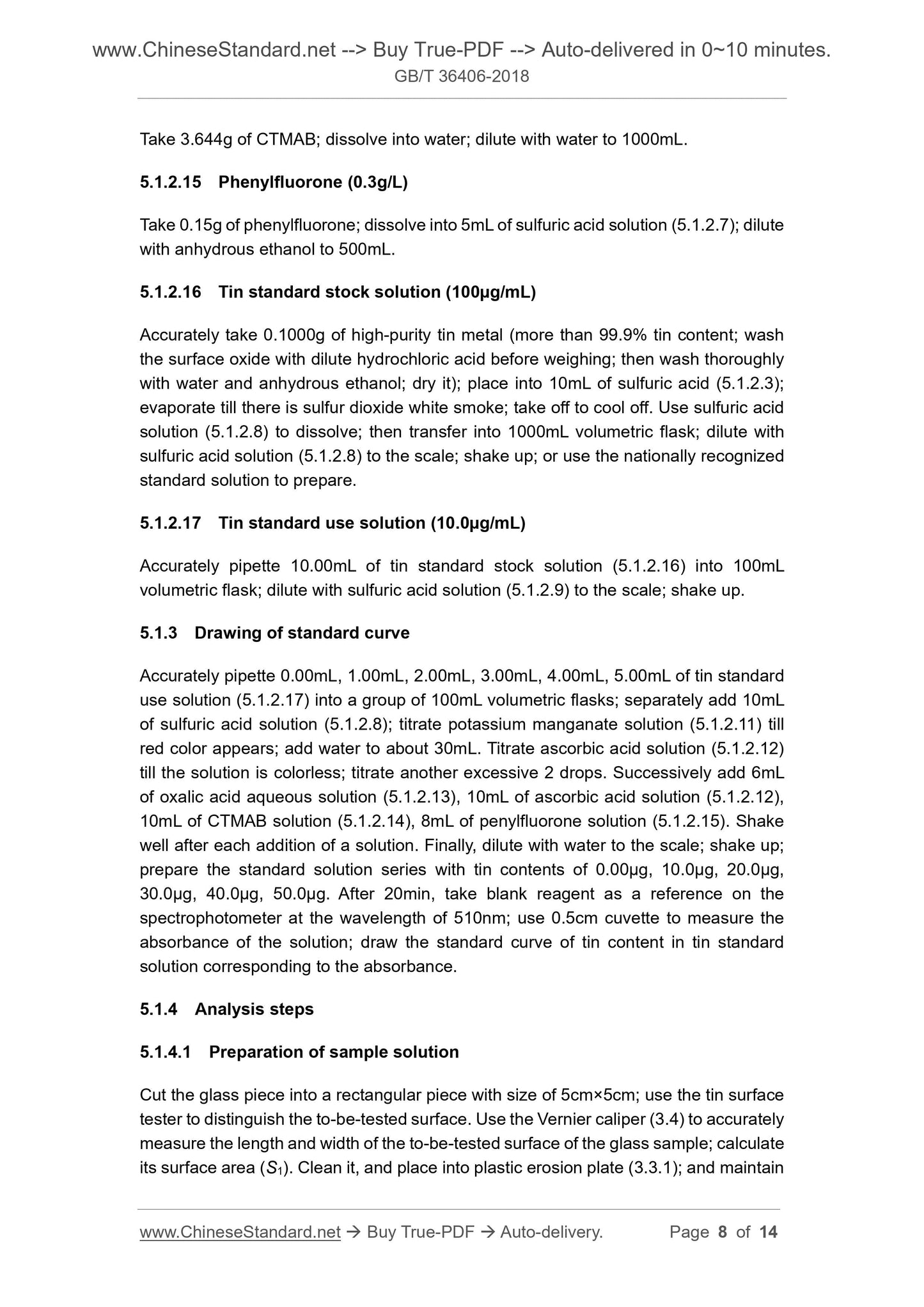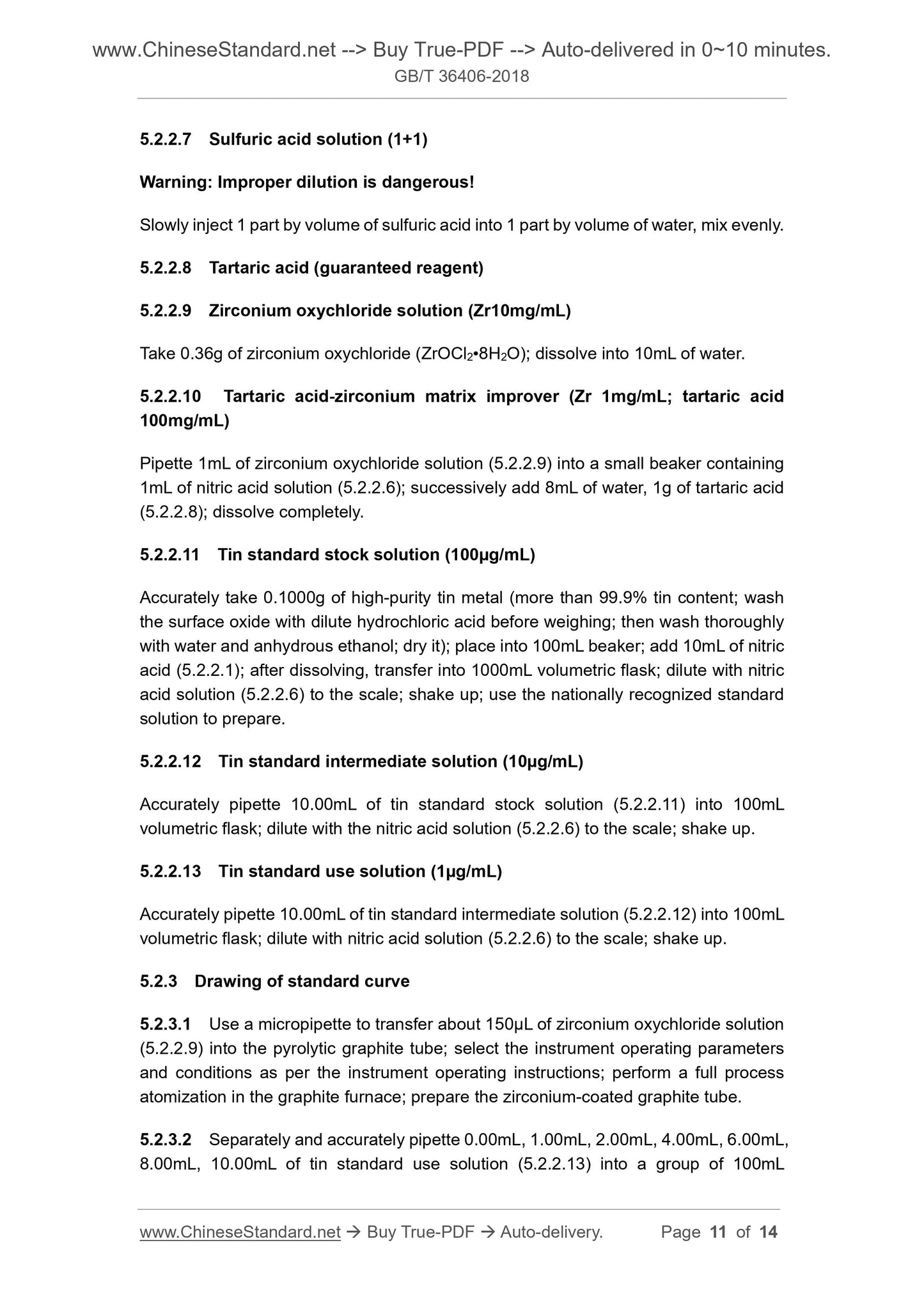1
/
of
6
PayPal, credit cards. Download editable-PDF & invoice in 1 second!
GB/T 36406-2018 English PDF (GBT36406-2018)
GB/T 36406-2018 English PDF (GBT36406-2018)
Regular price
$175.00 USD
Regular price
Sale price
$175.00 USD
Unit price
/
per
Shipping calculated at checkout.
Couldn't load pickup availability
Delivery: 3 seconds. Download true-PDF + Invoice.
Get QUOTATION in 1-minute: Click GB/T 36406-2018
Historical versions: GB/T 36406-2018
Preview True-PDF (Reload/Scroll if blank)
GB/T 36406-2018: Test method of tin penetrated on float glass surface
GB/T 36406-2018
GB
NATIONAL STANDARD OF THE
PEOPLE’S REPUBLIC OF CHINA
ICS 81.040.10
Q 33
Test Method of Tin
Penetrated on Float Glass Surface
ISSUED ON. JUNE 07, 2018
IMPLEMENTED ON. MAY 01, 2019
Issued by. State Administration for Market Regulation;
Standardization Administration of PRC.
Table of Contents
Foreword ... 3
1 Scope ... 4
2 Normative References ... 4
3 Apparatus ... 5
4 General Rules ... 5
5 Test Methods ... 6
6 Result Expression ... 14
7 Precision Requirements ... 14
8 Test Report ... 14
Test Method of Tin
Penetrated on Float Glass Surface
Warning. Personnel using this Standard shall have the practical working
experience in the formal laboratory. This Standard doesn’t address all the
possible security issues. It is the responsibility of the user to adopt appropriate
safety and health measures and ensure compliance with the relevant national
regulations.
1 Scope
This Standard specifies the apparatus, general rules, test methods, result expression,
precision requirements, test report for the test method of tin penetrated on float glass
surface.
This Standard is applicable to the flat glass produced by float process.
2 Normative References
The following documents are essential to the application of this document. For the
dated documents, only the versions with the dates indicated are applicable to this
document; for the undated documents, only the latest version (including all the
amendments) are applicable to this document.
GB/T 6682 Water for Analytical Laboratory Use – Specification and Test Methods
GB/T 8170 Rules of Rounding off for Numerical Values and Expression and
Judgement of Limiting Values
GB/T 9721 Chemical Reagent - General Rules for the Molecular Absorption
Spectrophotometry (Ultraviolet and Visible)
GB/T 12806 Laboratory Glassware - One-Mark Volumetric Flasks
GB/T 12808 Laboratory Glassware - One Mark Pipettes
GB/T 15337 General Rules for Atomic Absorption Spectrometric Analysis
GB/T 21389 Vernier Dial and Digital Display Calipers
the analytical grade; the used water shall be no less than Level-II water specified in
GB/T 6682.
4.2 Reagent
The density of commercially available solution reagents listed in this Standard refers
to the density (ρ) at 20°C ambient conditions. The unindicated concentration of the
used acid refers to the concentration of commercially available acid.
Use the volume ratio to express the dilution degree of the reagent, for instance,
hydrochloric acid (1+3) means that the 1 part by volume of concentrated hydrochloric
acid is mixed with 3 parts by volume of water.
4.3 Parallel test
Perform two sets of tests in parallel under repetitive conditions.
5 Test Methods
5.1 Phenylfluorone-cetyltrimethylammonium bromide spectrophotometry
5.1.1 Principle
The surface of the glass sample was etched with a mixed acid solution of hydrofluoric
acid-nitric acid; transfer all the penetrated tin into the mixed acid solution. Use
potassium permanganate to oxide all the divalent tin into tetravalent tin. Tin(Iv)-
phenylfluorone-cetyltrimethylammonium bromide forms a red ternary complex in a
sulfuric acid medium. Measure its absorbance at a wavelength of 510nm. In a certain
centration range, the absorbance is proportional to the concentration of tin. From this,
the amount of penetrated tin per unit surface area (µg/cm2) of the glass sample can be
calculated.
5.1.2 Reagent
5.1.2.1 Nitric acid
The density is about 1.42g/mL; the mass fraction is 65%~68%.
5.1.2.2 Hydrofluoric acid
Warning. Hydrofluoric acid is toxic and corrosive. Wear rubber gloves during
operation to prevent skin contact!
The density is about 1.14g/mL; the mass fraction is 40% above.
5.1.2.3 Sulfuric acid
Take 3.644g of CTMAB; dissolve into water; dilute with water to 1000mL.
5.1.2.15 Phenylfluorone (0.3g/L)
Take 0.15g of phenylfluorone; dissolve into 5mL of sulfuric acid solution (5.1.2.7); dilute
with anhydrous ethanol to 500mL.
5.1.2.16 Tin standard stock solution (100µg/mL)
Accurately take 0.1000g of high-purity tin metal (more than 99.9% tin content; wash
the surface oxide with dilute hydrochloric acid before weighing; then wash thoroughly
with water and anhydrous ethanol; dry it); place into 10mL of sulfuric acid (5.1.2.3);
evaporate till there is sulfur dioxide white smoke; take off to cool off. Use sulfuric acid
solution (5.1.2.8) to dissolve; then transfer into 1000mL volumetric flask; dilute with
sulfuric acid solution (5.1.2.8) to the scale; shake up; or use the nationally recognized
standard solution to prepare.
5.1.2.17 Tin standard use solution (10.0µg/mL)
Accurately pipette 10.00mL of tin standard stock solution (5.1.2.16) into 100mL
volumetric flask; dilute with sulfuric acid solution (5.1.2.9) to the scale; shake up.
5.1.3 Drawing of standard curve
Accurately pipette 0.00mL, 1.00mL, 2.00mL, 3.00mL, 4.00mL, 5.00mL of tin standard
use solution (5.1.2.17) into a group of 100mL volumetric flasks; separately add 10mL
of sulfuric acid solution (5.1.2.8); titrate potassium manganate solution (5.1.2.11) till
red color appears; add water to about 30mL. Titrate ascorbic acid solution (5.1.2.12)
till the solution is colorless; titrate another excessive 2 drops. Successively add 6mL
of oxalic acid aqueous solution (5.1.2.13), 10mL of ascorbic acid solution (5.1.2.12),
10mL of CTMAB solution (5.1.2.14), 8mL of penylfluorone solution (5.1.2.15). Shake
well after each addition of a solution. Finally, dilute with water to the scale; shake up;
prepare the standard solution series with tin contents of 0.00µg, 10.0µg, 20.0µg,
30.0µg, 40.0µg, 50.0µg. After 20min, take blank reagent as a reference on the
spectrophotometer at the wavelength of 510nm; use 0.5cm cuvette to measure the
absorbance of the solution; draw the standard curve of tin content in tin standard
solution corresponding to the absorbance.
5.1.4 Analysis steps
5.1.4.1 Preparation of sample solution
Cut the glass piece into a rectangular piece with size of 5cm×5cm; use the tin surface
tester to distinguish the to-be-tested surface. Use the Vernier caliper (3.4) to accurately
measure the length and width of the to-be-tested surface of the glass sample; calculate
its surface area (S1). Clean it, and place into plastic erosion plate (3.3.1); and maintain
5.2.2.7 Sulfuric acid solution (1+1)
Warning. Improper dilution is dangerous!
Slowly inject 1 part by volume of sulfuric acid into 1 part by volume of water, mix evenly.
5.2.2.8 Tartaric acid (guaranteed reagent)
5.2.2.9 Zirconium oxychloride solution (Zr10mg/mL)
Take 0.36g of zirconium oxychloride (ZrOCl2•8H2O); dissolve into 10mL of water.
5.2.2.10 Tartaric acid-zirconium matrix improver (Zr 1mg/mL; tartaric acid
100mg/mL)
Pipette 1mL of zirconium oxychloride solution (5.2.2.9) into a small beaker containing
1mL of nitric acid solution (5.2.2.6); successively add 8mL of water, 1g of tartaric acid
(5.2.2.8); dissolve completely.
5.2.2.11 Tin standard stock solution (100µg/mL)
Accurately take 0.1000g of high-purity tin metal (more than 99.9% tin content; wash
the surface oxide with dilute hydrochloric acid before weighing; then wash thoroughly
with water and anhydrous ethanol; dry it); place into 100mL beaker; add 10mL of nitric
acid (5.2.2.1); after dissolving, transfer into 1000mL volumetric flask; dilute with nitric
acid solution (5.2.2.6) to the scale; shake up; use the nationally recognized standard
solution ...
Get QUOTATION in 1-minute: Click GB/T 36406-2018
Historical versions: GB/T 36406-2018
Preview True-PDF (Reload/Scroll if blank)
GB/T 36406-2018: Test method of tin penetrated on float glass surface
GB/T 36406-2018
GB
NATIONAL STANDARD OF THE
PEOPLE’S REPUBLIC OF CHINA
ICS 81.040.10
Q 33
Test Method of Tin
Penetrated on Float Glass Surface
ISSUED ON. JUNE 07, 2018
IMPLEMENTED ON. MAY 01, 2019
Issued by. State Administration for Market Regulation;
Standardization Administration of PRC.
Table of Contents
Foreword ... 3
1 Scope ... 4
2 Normative References ... 4
3 Apparatus ... 5
4 General Rules ... 5
5 Test Methods ... 6
6 Result Expression ... 14
7 Precision Requirements ... 14
8 Test Report ... 14
Test Method of Tin
Penetrated on Float Glass Surface
Warning. Personnel using this Standard shall have the practical working
experience in the formal laboratory. This Standard doesn’t address all the
possible security issues. It is the responsibility of the user to adopt appropriate
safety and health measures and ensure compliance with the relevant national
regulations.
1 Scope
This Standard specifies the apparatus, general rules, test methods, result expression,
precision requirements, test report for the test method of tin penetrated on float glass
surface.
This Standard is applicable to the flat glass produced by float process.
2 Normative References
The following documents are essential to the application of this document. For the
dated documents, only the versions with the dates indicated are applicable to this
document; for the undated documents, only the latest version (including all the
amendments) are applicable to this document.
GB/T 6682 Water for Analytical Laboratory Use – Specification and Test Methods
GB/T 8170 Rules of Rounding off for Numerical Values and Expression and
Judgement of Limiting Values
GB/T 9721 Chemical Reagent - General Rules for the Molecular Absorption
Spectrophotometry (Ultraviolet and Visible)
GB/T 12806 Laboratory Glassware - One-Mark Volumetric Flasks
GB/T 12808 Laboratory Glassware - One Mark Pipettes
GB/T 15337 General Rules for Atomic Absorption Spectrometric Analysis
GB/T 21389 Vernier Dial and Digital Display Calipers
the analytical grade; the used water shall be no less than Level-II water specified in
GB/T 6682.
4.2 Reagent
The density of commercially available solution reagents listed in this Standard refers
to the density (ρ) at 20°C ambient conditions. The unindicated concentration of the
used acid refers to the concentration of commercially available acid.
Use the volume ratio to express the dilution degree of the reagent, for instance,
hydrochloric acid (1+3) means that the 1 part by volume of concentrated hydrochloric
acid is mixed with 3 parts by volume of water.
4.3 Parallel test
Perform two sets of tests in parallel under repetitive conditions.
5 Test Methods
5.1 Phenylfluorone-cetyltrimethylammonium bromide spectrophotometry
5.1.1 Principle
The surface of the glass sample was etched with a mixed acid solution of hydrofluoric
acid-nitric acid; transfer all the penetrated tin into the mixed acid solution. Use
potassium permanganate to oxide all the divalent tin into tetravalent tin. Tin(Iv)-
phenylfluorone-cetyltrimethylammonium bromide forms a red ternary complex in a
sulfuric acid medium. Measure its absorbance at a wavelength of 510nm. In a certain
centration range, the absorbance is proportional to the concentration of tin. From this,
the amount of penetrated tin per unit surface area (µg/cm2) of the glass sample can be
calculated.
5.1.2 Reagent
5.1.2.1 Nitric acid
The density is about 1.42g/mL; the mass fraction is 65%~68%.
5.1.2.2 Hydrofluoric acid
Warning. Hydrofluoric acid is toxic and corrosive. Wear rubber gloves during
operation to prevent skin contact!
The density is about 1.14g/mL; the mass fraction is 40% above.
5.1.2.3 Sulfuric acid
Take 3.644g of CTMAB; dissolve into water; dilute with water to 1000mL.
5.1.2.15 Phenylfluorone (0.3g/L)
Take 0.15g of phenylfluorone; dissolve into 5mL of sulfuric acid solution (5.1.2.7); dilute
with anhydrous ethanol to 500mL.
5.1.2.16 Tin standard stock solution (100µg/mL)
Accurately take 0.1000g of high-purity tin metal (more than 99.9% tin content; wash
the surface oxide with dilute hydrochloric acid before weighing; then wash thoroughly
with water and anhydrous ethanol; dry it); place into 10mL of sulfuric acid (5.1.2.3);
evaporate till there is sulfur dioxide white smoke; take off to cool off. Use sulfuric acid
solution (5.1.2.8) to dissolve; then transfer into 1000mL volumetric flask; dilute with
sulfuric acid solution (5.1.2.8) to the scale; shake up; or use the nationally recognized
standard solution to prepare.
5.1.2.17 Tin standard use solution (10.0µg/mL)
Accurately pipette 10.00mL of tin standard stock solution (5.1.2.16) into 100mL
volumetric flask; dilute with sulfuric acid solution (5.1.2.9) to the scale; shake up.
5.1.3 Drawing of standard curve
Accurately pipette 0.00mL, 1.00mL, 2.00mL, 3.00mL, 4.00mL, 5.00mL of tin standard
use solution (5.1.2.17) into a group of 100mL volumetric flasks; separately add 10mL
of sulfuric acid solution (5.1.2.8); titrate potassium manganate solution (5.1.2.11) till
red color appears; add water to about 30mL. Titrate ascorbic acid solution (5.1.2.12)
till the solution is colorless; titrate another excessive 2 drops. Successively add 6mL
of oxalic acid aqueous solution (5.1.2.13), 10mL of ascorbic acid solution (5.1.2.12),
10mL of CTMAB solution (5.1.2.14), 8mL of penylfluorone solution (5.1.2.15). Shake
well after each addition of a solution. Finally, dilute with water to the scale; shake up;
prepare the standard solution series with tin contents of 0.00µg, 10.0µg, 20.0µg,
30.0µg, 40.0µg, 50.0µg. After 20min, take blank reagent as a reference on the
spectrophotometer at the wavelength of 510nm; use 0.5cm cuvette to measure the
absorbance of the solution; draw the standard curve of tin content in tin standard
solution corresponding to the absorbance.
5.1.4 Analysis steps
5.1.4.1 Preparation of sample solution
Cut the glass piece into a rectangular piece with size of 5cm×5cm; use the tin surface
tester to distinguish the to-be-tested surface. Use the Vernier caliper (3.4) to accurately
measure the length and width of the to-be-tested surface of the glass sample; calculate
its surface area (S1). Clean it, and place into plastic erosion plate (3.3.1); and maintain
5.2.2.7 Sulfuric acid solution (1+1)
Warning. Improper dilution is dangerous!
Slowly inject 1 part by volume of sulfuric acid into 1 part by volume of water, mix evenly.
5.2.2.8 Tartaric acid (guaranteed reagent)
5.2.2.9 Zirconium oxychloride solution (Zr10mg/mL)
Take 0.36g of zirconium oxychloride (ZrOCl2•8H2O); dissolve into 10mL of water.
5.2.2.10 Tartaric acid-zirconium matrix improver (Zr 1mg/mL; tartaric acid
100mg/mL)
Pipette 1mL of zirconium oxychloride solution (5.2.2.9) into a small beaker containing
1mL of nitric acid solution (5.2.2.6); successively add 8mL of water, 1g of tartaric acid
(5.2.2.8); dissolve completely.
5.2.2.11 Tin standard stock solution (100µg/mL)
Accurately take 0.1000g of high-purity tin metal (more than 99.9% tin content; wash
the surface oxide with dilute hydrochloric acid before weighing; then wash thoroughly
with water and anhydrous ethanol; dry it); place into 100mL beaker; add 10mL of nitric
acid (5.2.2.1); after dissolving, transfer into 1000mL volumetric flask; dilute with nitric
acid solution (5.2.2.6) to the scale; shake up; use the nationally recognized standard
solution ...
Share
